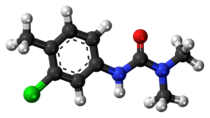클로르톨루론
Chlortoluron | |
 | |
| 이름 | |
|---|---|
| 선호 IUPAC 이름 N′-(3-클로로-4-메틸페닐)-N, N-디메틸루레아 | |
| 기타 이름 3-(3-클로로-4-메틸페닐)-1,1-디메틸루레아 | |
| 식별자 | |
3D 모델(JSmol) | |
| 체비 | |
| 켐스파이더 | |
| ECHA InfoCard | 100.035.978 |
| EC 번호 |
|
펍켐 CID | |
| 유니 | |
CompTox 대시보드 (EPA) | |
| |
| |
| 속성[1] | |
| C10H13ClN2O | |
| 어금질량 | 212.67602 |
| 녹는점 | 148°C(298°F, 421K) |
| 로그 P | 2.41 |
| 위험[2] | |
| GHS 라벨 표시: | |
  | |
| 경고 | |
| H351, H361d, H410 | |
| P201, P202, P273, P281, P308+P313, P391, P405, P501 | |
달리 명시된 경우를 제외하고, 표준 상태(25°C [77°F], 100 kPa)의 재료에 대한 데이터가 제공된다. | |
| Infobox 참조 자료 | |
클로르톨루론(Chlortoluron) 또는 클로로톨루론(Clorotoluron)은 곡물 작물에서 넓은 잎과 연간 풀 잡초를 조절하는 데 사용되는 페닐루레아 제초제의 유기 화합물의 일반적인 이름이다[3].
역사
1952년 E. I. du Pont de Nemours and Company의 화학자들은 일련의 아릴 요소 유도체를 제초제로서 특허를 얻었다. 이 특허가 적용되는 여러 화합물인 모누론(4-클로로페닐), 디우론(3,4-디클로로페닐), 클로르톨루론(3-클로로페닐)과 클로르톨루론(3-클로로포4-메틸페닐)이 제초제로 상용화됐다.[4][5] 그 후, 동일한 행동 메커니즘을 가진 30개 이상의 관련 요소 아날로그가 전 세계적으로 시장에 도달했다.[6]
합성
퐁 특허에 기술된 바와 같이 출발 물질은 아닐아민인 대체 아릴아민으로 아닐아민으로, 포스겐으로 처리되어 이소시아네이트 파생 물질은 아닐아민이다. 이는 이후 디메틸아민에 반응하여 최종 제품을 공급한다.[4]
- 아릴-NH2 + COCl2 → 아릴-NCO
- 아릴-NCO + NH(CH3)2 → 아릴-NHCON(CH3)2
작용기전
클로르톨루론을 포함한 제초제의 페닐루레아 등급은 광합성 억제제다. 포토시스템 II의 Q플라토키논B 결합 사이트를 차단해 Q에서A Q로B 전자의 흐름을 차단한다.[7] 이것은 광합성 전자 운송 체인을 방해하고 식물을 죽인다.[8]
사용법
클로르톨루론은 1994년[9] 유럽연합(EU)[10]에서 처음 사용 허가를 받았으며, 이는 2021년 10월까지 연장되었다. 현재는 주로 이플루페니칸과 펜디메탈린을 포함한 다른 제초제와 혼합하여 사용된다.[11]
It can be used to control broadleaf weeds and grasses including Alopecurus myosuroides, Anthemis arvensis, Atriplex prostrata, Calendula spp., Convolvulaceae spp., Galeopsis spp., Lamium spp., Papaver rhoeas, Paspalum distichum, Poa annua, Solanaceae spp., Stellaria media and Veronica spp. 그것은 주로 밀과 보리를 포함한 곡물 작물에 사용된다.[9][11]
참조
- ^ EPA Comptox database. "Chlorotoluron". comptox.epa.gov. Retrieved 2021-03-26.
- ^ PubChem database. "Chlorotoluron". pubchem.ncbi.nlm.nih.gov. Retrieved 2021-03-27.
- ^ "Compendium of Pesticide Common Names". alanwood.net.
- ^ a b 미국 특허권 2655445, Todd C.W., "3-(할로페닐)-1-메틸-1-(메틸 또는 에틸) 요소 및 제초제 성분과 이를 채택한 방법"을 발행하고, 1953-10-13을 E. I. du Nemours & Co.에 할당했다.
- ^ Liu, Jing (2010). "Phenylurea Herbicides". Hayes' Handbook of Pesticide Toxicology. pp. 1725–1731. doi:10.1016/B978-0-12-374367-1.00080-X. ISBN 9780123743671.
- ^ "Urea herbicides". alanwood.net. Retrieved 2021-03-26.
- ^ Broser, Matthias; Glöckner, Carina; Gabdulkhakov, Azat; Guskov, Albert; Buchta, Joachim; Kern, Jan; Müh, Frank; Dau, Holger; Saenger, Wolfram; Zouni, Athina (2011). "Structural Basis of Cyanobacterial Photosystem II Inhibition by the Herbicide Terbutryn". Journal of Biological Chemistry. 286 (18): 15964–15972. doi:10.1074/jbc.M110.215970. PMC 3091205. PMID 21367867.
- ^ Oettmeier, Walter (1992). "Herbicides of photosystem II". The Photosystems. pp. 349–408. doi:10.1016/B978-0-444-89440-3.50018-7. ISBN 9780444894403.
- ^ a b Pesticide Properties Database. "Chlorotoluron". University of Hertfordshire. Retrieved 2021-03-27.
- ^ "Commission implementing regulation (EU) 2020/1511". 2020-10-16. Retrieved 2021-03-27.
- ^ a b Adama (2017). "Tower" (PDF). pcs.agriculture.gov.ie. Retrieved 2021-03-27.


